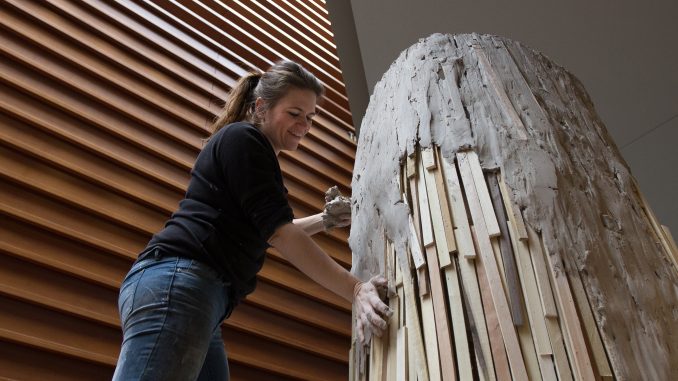
Ceramicist Shay Church would rather show his work in a living room than a gallery—he likes to work in places that “have context.”
“I love places that are already full of history,” said Church, the artist behind “Stand,” a large-scale exhibit featured at the opening ceremony of the Philadelphia International Festival of the Arts. “I’m really interested in that instead of a white box.”
PIFA, a biannual festival created by the Kimmel Center for the Performing Arts, helped Church to do just that. Church’s installation is large scale and replicates trees in a forest. The piece is made almost entirely of recycled materials, like reclaimed wood and excess clays that would have been thrown out by manufacturers.
PIFA began on April 8 and will run through April 23. The festival will showcase both local and international artists in a series of more than 60 events. This third installation of the festival is centered around the concept of, “We Are What We Make.”
“[PIFA] is an opportunity to produce work outside of our building and to work with artists outside of our building,” said the Kimmel Center’s artistic director, Jay Wahl. “It gives us the opportunity to partner with other organizations in the city. This year, we want to focus on the relationship between the way we make things, the people we make them with, and the things we make them out of.”
Wahl said the Kimmel Center first noticed Church’s work through The Clay Studio at 139 N. 2nd St., adding that Church’s proposal of large-scale clay trees for his PIFA installation “coincides with the idea that man can make almost anything, but we can’t make a tree.”
“I liked the questions that he was asking with his work, and those were the questions that I wanted to pose with the festival,” he added.
Church said that most, if not all of his work, “reflects on the environment.”
“I think we all have really fond memories of trees and forests as things we grew up with,” he added. “[Stand] is not a specific forest, just reflective of all of those memories. To me, the idea of the trees just worked really well with the space.”
Church never realized his passion for ceramics until he received a scholarship to go to Japan during his time as an undergraduate student at Western Michigan University.
“Funny thing is it took me to go to Japan to encounter my first real ceramics studio,” he said of his time studying under world-renowned ceramicist Ryoji Koie. “All of a sudden, I just started falling in love with ceramic work.”

Church said PIFA appealed to him because of its inclusive nature.
“I really like that [PIFA] combined visual art, music, theater and performance,” Church said. “That I really thought was interesting.”
Church’s piece is housed in the atrium of the Kimmel Center, and will be left to dry and crack until the conclusion of the festival. On April 9 and 10, the public was invited to add clay to the installation.
“It takes a lot of labor to put all of this clay on,” Church said. “When I started doing these projects 10 years ago, I’ve just always had people help me out.”
Church began to make large-scale wet clay pieces when he was in graduate school earning a degree in spatial arts at San Jose State University.
“The very first one I made was a dead elk in my graduate studio,” he said. “I had this 10-by-10 cubicle. The clay when it’s wet almost looks alive. It’s this transformation through an exhibition or a period of time that I think is interesting.”
Church said he liked the initial reactions that people had to the elk because of its appearance and its size in the space provided. After this experience, he continued to produce large-scale pieces out of wet clay, enjoying the way the pieces would grow and shift.
Church said “the process becomes a part of the piece.”
“At the opening, it will be in one state, and in three days it’s going to look different, and three days from then, when it’s cracking and falling apart, it’s going to look different,” he said. “By the end when the exhibition is over, it will be completely cracked, and then it’s ripped out and it’s done.”
Wahl said the festival isn’t trying to share a specific message, but pose questions to attendees of the events.
“We are asking what art can do,” he added. “Art teaches us empathy for each other and asks us where we’ve been as a community, where are we now and where are we going. I think that’s what the festival is meant to do, to provoke those questions.”
Erin Blewett can be reached at erin.clare.blewett@temple.edu.


Be the first to comment